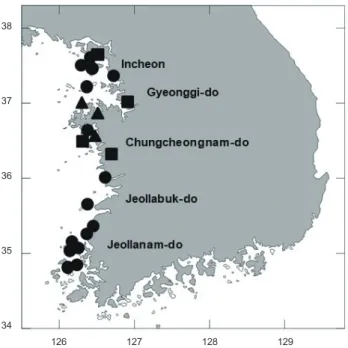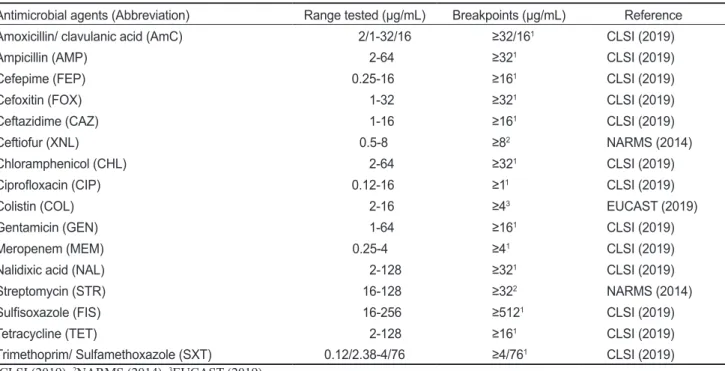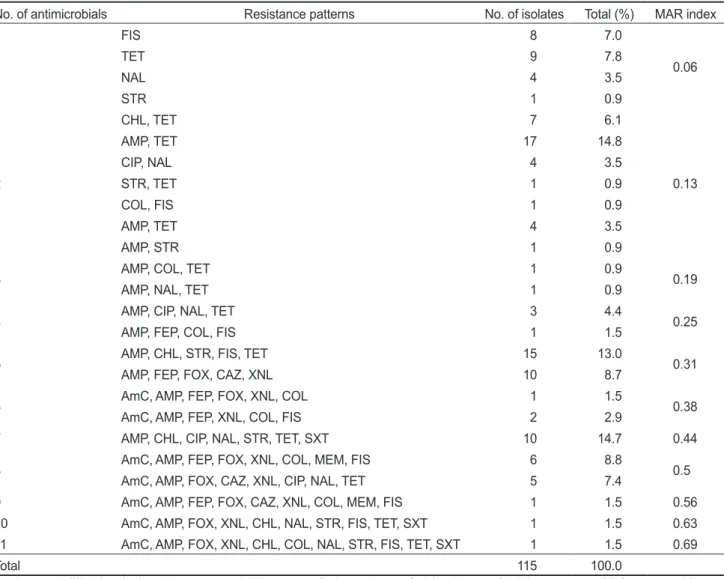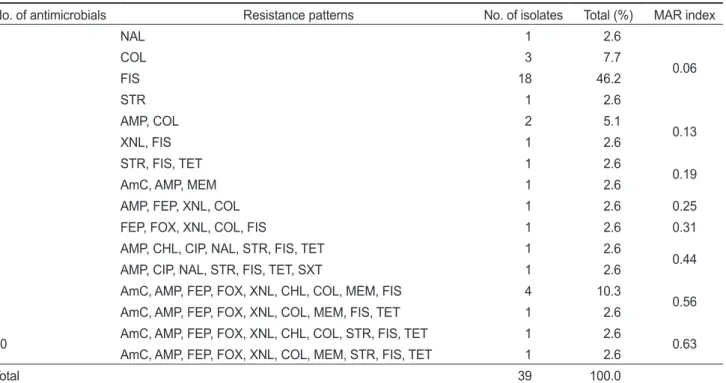388
Copyright © 2021 The Korean Society of Fisheries and Aquatic Science pISSN:0374-8111, eISSN:2287-8815
서 론
항생제는인간은물론이고축
·
수산물의질병을치료하고예 방하기위한필수의약품이며,
축·
수산업의발전에기여한바가 크다.
국내항생제판매량은2015
년약910
톤, 2016
년약964
톤, 2017
년약1,027
톤, 2018
년약984
톤, 2019
년약927
톤으로매년비슷한판매량을유지하고있다
(MFDS, 2019).
그러나항생제사용에따른내성균의발생및광범위한유행은치료법 이없는새로운감염병발생이상의파급력을가지며
,
사망률의 증가,
치료기간의연장및의료비용의상승등사회경제적인손 실은물론,
공중보건에있어큰위협이된다(WHO, 2014; Lee
et al., 2019).
WHO (World Health Organization)
에서 제시하는 항생제 내성의 주요 원인은항생제의 오·
남용이라고 정하고있으며(WHO, 2014)
수산물에서도항생제내성균의출현이보고되었다
.
수산물에서의항생제내성균발생원인은항생제의오·
남 용뿐만아니라항생제를투여한축산동물이나인간의분변으 로부터발생한항생제내성균이자연환경으로방출되거나축 산동물,
인간에게투여한항생제가성분이변하지않은상태로 배설된다는보고도있다(Kummerer, 2009; Park et al., 2013).
항생제내성뿐만아니라다제내성의출현은더욱심각한문 제를야기한다
. Song (2009)
은항생제에다제내성을가지는세서해안 수산생물에서 분리한 대장균(Escherichia coli)의 항생제 내성 및 다제 내성 양상 비교
정연겸·박보미·김민주·박진일·정연중
1·오은경*
국립수산과학원 서해수산연구소, 1국립수산과학원 식품위생가공과
Comparison of Antimicrobial Resistance and Multi-Drug Resistance Patterns of Escherichia coli Isolated from Aquatic Organisms Off the West Coast of South Korea
Yeon Gyeom Jeong, Bo Mi Park, Min Ju Kim, Jin Il Park, Yeoun Joong Jung
1
and Eun Gyoung Oh*West Sea Fisheries Research Institute, National Institute of Fisheries Science, Incheon 22383, Korea
1Food Safety and Processing Research Division, National Institute of Fisheries Science, Busan 46083, Korea
Antimicrobial resistance patterns of Escherichia coli were investigated. Strains were isolated from 310 shellfish, 36 crustaceans, and 12 fish collected off the West Coast of Korea from April 2019 to October 2020. Two hundred and ninety-five E. coli strains were isolated from shellfish, 100 from crustaceans, and 54 from fish. Strains isolated from shellfish showed the highest resistance to ampicillin (27.5%), whereas those from crustaceans were resistant to sulfisoxazole (30.0%) and those from fish were resistant to ampicillin (59.3%) and sulfisoxazole (59.3%). Ceftazi- dime resistance was observed in strains isolated from short neck and hard clams, whereas gentamicin resistance was observed in strains from fish. Multi-drug resistance was observed in 56 strains (48.7%) isolated from shellfish, 11 (28.2%) from crustaceans and 27 (73.0%) from fish. Depending on the source of isolation, the strains showed specific antimicrobial resistance tendency. Strains isolated from shellfish showed 12 different multi-drug resistance patterns, whereas those from crustaceans showed high resistance (59%) to a single antimicrobial agent and those from fish showed a broad trend of multi-drug resistance to more than eight antimicrobials.
Keywords: Antimicrobial resistance, Aquatic organism, Escherichia coli , Multi-drug resistance, West coast
*Corresponding author: Tel: +82. 32. 745. 0750 Fax: +82. 32. 745. 0619 E-mail address: ohdagu@korea.kr
This is an Open Access article distributed under the terms of the Creative Commons Attribution Non-Commercial Licens (http://creativecommons.org/licenses/by-nc/3.0/) which permits unrestricted non-commercial use, distribution, and reproduction in any medium, provided the original work is properly cited.
Received 25 June 2021; Revised 14 July 2021; Accepted 22 July 2021
저자 직위: 정연겸(연구사), 박보미(연구원), 김민주(연구원), 박진일(연구사), 정연중(연구사), 오은경(연구관)
https://doi.org/10.5657/KFAS.2021.0388
Korean J Fish Aquat Sci 54(4), 388-396, August 2021
균에효과적인새로운항생제는매우드문실정이며특히그람 음성다제내성균에대한새로운항생제는전무한실정이라고 보고하고있다
. Muller et al. (2018)
은해양에서도항생제에대 한다제내성균이다수검출되고있고세균간플라스미드등유 전물질을교환하여다제내성을전이시킬수있다고보고하였 다.
그러나앞서보고된문제에도불구하고항생제개발에오랜 시간및비용이들고새롭게개발되더라도다시내성을획득하 는문제때문에많은제약회사들이항생제개발을포기하고있 어그심각성은더해지고있으며(Song, 2009)
문제해결을위한 예방및관리대책이필요한실정이다.
축
·
수산물에서의항생제내성은Escherichia coli, Enterococ- cus spp., Salmonella spp., Staphylococcus aureus, Campylo- bacter jejuni, Campylobacter coli, Vibrio parahaemolyticus
등 위생지표세균,
식중독세균,
병원성세균을분리하여검사를실 시하고있다(MFDS, 2019).
그중대장균(E. coli)
은대표적인 위생지표세균일뿐만아니라(FDA, 2019)
인간또는동물의장 내에상존하는세균이며항생제투여시빈번하게노출되기때 문에항생제에의한내성획득과정및내성균의모니터링에매 우유용한세균으로알려져있다(Levin et al., 1997).
이와같은 이유로수산생물의항생제내성에관한다양한연구들이수행 되어왔으며특히분변오염의지표로사용되는미생물인대장균
(E. coli)
의항생제내성에관한다양한연구가수행되어왔다(Son et al., 2009; Park et al., 2013; Jo et al., 2016; Kwon et al., 2016; Ryu et al., 2017; Kwon et al., 2019).
하지만이처럼특정 지역에서의단일수산생물에대한연구는다양하게진행되었지 만,
다양한수산생물의항생제내성을비교한연구는부족하다.
본연구에서는다양한수산생물에서분리되는항생제내성균 에대한비교자료를제공하고자서해안연안의수산생물로부 터분리한대장균에대한항생제내성및다제내성양상을비 교하였다.
재료 및 방법
시험 시료
시험에 사용된 시료는
2019
년4
월부터2020
년10
월 사이 에서해안연안에서채취한패류시료310
개,
갑각류시료36
개,
어류시료12
개이며,
채취지점을Fig. 1
에나타내었다.
굴(Crassostrea gigas)
은인천광역시옹진군,
충청남도태안군,
전 라남도신안군,
무안군및함평군의패류생산해역에서총206
개의시료를채취하였다.
바지락(Venerupis philippinarum)
은 인천광역시옹진군,
충청남도보령시및당진시,
전라북도부안 군,
전라남도신안군의패류생산해역에서총96
개의시료를채 취하였다.
전복(Haliotis discus)
은충청남도태안군,
전라남도 신안군의전복양식장에서총6
개의시료를채취하였다.
백합(Meretrix lusoria)
은전라남도영광군의패류생산해역에서총2
개의시료를채취하였다.
채취한패류시료는멸균된황동솔로표면을세척한후탈각하여멸균된용기에담아시험에사용 하였다
.
새우(Litopenaeus vannamei)
는인천광역시강화군,
경 기도평택시,
충청남도서천군및태안군의실내수조및야외 호지로이루어진새우양식장에서총36
개의시료를시험에사 용하였다.
새우의표면을세척한후머리와내장만취하여시험 에사용하였다.
조피볼락(Sebastes schlegelii)
은충청남도태안 군영목항의해상가두리양식장에서총8
개의시료를시험에 사용하였으며,
숭어(Mugil cephalus)
는충청남도태안군당암 리의해상가두리양식장에서총4
개의시료를시험에사용하 였다.
어류시료는표면을세척한후아가미와내장만취하여시 험에사용하였다.
대장균 시험 및 분리 동정
대장균시험은
recommended procedures for the examination of sea water and shellfish (APHA, 1970)
및International Or- ganization for Standardization (ISO, 2015)
분석법에준하여 실시하였다. Blending
한각각의시료25 g
을EC broth (Oxoid, Basingstoke, UK) 225 mL
에접종하여44.5±0.2°C
에서18-24
시간 증균배양 후tryptone bile X-glucuronide agar (Oxoid, Basingstoke, UK)
평판5
장에각각streaking
하여44±1°C
에서18-24
시간분리배양하였다.
분리배양후평판에서청색(blue)
또는청록색(blue-green)
의colony
를선택하여tryptone soya agar (Oxoid, Basingstoke, UK)
평판에streaking, 37±1°C
에 서18-24
시간순수배양한후VITEK2 System (BioMerieux, Marcy, France)
으로동정하였다.
Fig. 1. Sampling stations of shellfish (●), crustacean (■) and fish (▲) of West coast of South Korea.
38
37
36
35
34
126 127 128 129
최소억제농도법(Minimum Inhibitory Concentrations, MICs)을 이용한 항생제 내성 시험
최소억제농도법
(minimum inhibitory concentrations, MICs)
을이용한항생제내성시험은식품의약품안전처(Ministry of Food and Drug Safety, MFDS)
에서제공하는국가항생제사 용및 내성모니터링(MFDS, 2019)
에준하여실시하였으며,
내성을판정하는 기준은Clinical and Laboratory Standards Institute (CLSI, 2019)
를근거로하였다(Table 1). VITEK2
로 최종확인및동정한분리균주를mueller-hinton agar (Oxoid, Basingstoke, UK)
평판에streaking
하여37±1°C
에서18-20
시 간배양한후평판배지에서약3-5
개집락을loop
로취하여5 mL
멸균증류수에현탁하여0.5 McFarland
로탁도를조정하 였다.
탁도를조정한현탁액을cation adjusted mueller-hinton broth (Sensititre, Lenexa, KS, USA) 11 mL tube
에10 μL
넣 어충분히vortexing
한후검사항생제가농도별로coating
된KRNV5F MIC panel (Sensititre, East Grinstead, UK)
에자동 분주접종기(auto inoculator, AIM)
를이용하여50 μL
씩분주 하고35±0.5°C
에서18-24
시간배양하였다.
이때, MIC panel
은MFDS (2019)
에따라주문제작하여사용하였다.
배양이완 료된MIC panel
을Optiread (Sensititre, East Grinstead, UK)
로판독하여완전히균의증식이억제된가장낮은농도를최 소억제농도(MICs)
로판정하였다.
판정된MIC
농도를항생제 내성기준(breakpoints)
과비교하여내성및감수성을판정하였 다.
분리균주의항생제다제내성정도는MAR (multiple anti- microbial resistance) index
로나타내었으며, MAR index
는항생제내성시험에사용된총항생제종류의수
(16
종)
에대한내 성을나타내는항생제종류의수의비율(
내성을나타내는항생 제종류의수/
시험에사용된총항생제종류의수)
로계산하였 다(Krumperman, 1983; Titilawo et al., 2015).
결과 및 고찰
서해안 수산생물 중 대장균의 검출 및 분리 현황 2019
년4
월부터2020
년10
월까지서해안연안에서채취한 수산생물의대장균분리결과를Table 2
에나타내었다.
패류중 굴(Crassostrea gigas)
은총206
개시료에서대장균125
균주를 분리했으며,
바지락(Venerupis philippinarum)
은총96
개시료 에서111
균주,
전복(Haliotis discus)
은총6
개시료에서34
균 주,
백합(Meretrix lusoria)
은총2
개시료에서25
균주를분리 했다.
갑각류인새우(Litopenaeus vannamei)
는총36
개의시료 에서대장균100
균주를분리했다.
어류중조피볼락(Sebastes schlegelii)
은총8
개시료에서대장균19
균주를분리했으며,
숭 어(Mugil cephalus)
는총4
개시료에서35
균주를분리했다. 대장균의 항생제 종류별 내성
서해안의수산생물에서분리된대장균총
449
균주의16
종항 생제에대한내성을Table 3
에나타내었다.
패류,
갑각류,
어류에서분리한대장균의항생제내성률은
ampicillin
이가장높았고
(28.1%), tetracycline (24.3%), sulfisoxazole (22.0%), strep- tomycin (14.0%), nalidixic acid (12.0%)
순으로높은항생제 내성률을보였다.
Table 1. Types of antimicrobials and breakpoints used in Escherichia coli's MIC test
Antimicrobial agents (Abbreviation) Range tested (μg/mL) Breakpoints (μg/mL) Reference
Amoxicillin/ clavulanic acid (AmC) 2/1-32/16 ≥32/161 CLSI (2019)
Ampicillin (AMP) 2-64 ≥321 CLSI (2019)
Cefepime (FEP) 0.25-16 ≥161 CLSI (2019)
Cefoxitin (FOX) 1-32 ≥321 CLSI (2019)
Ceftazidime (CAZ) 1-16 ≥161 CLSI (2019)
Ceftiofur (XNL) 0.5-8 ≥82 NARMS (2014)
Chloramphenicol (CHL) 2-64 ≥321 CLSI (2019)
Ciprofloxacin (CIP) 0.12-16 ≥11 CLSI (2019)
Colistin (COL) 2-16 ≥43 EUCAST (2019)
Gentamicin (GEN) 1-64 ≥161 CLSI (2019)
Meropenem (MEM) 0.25-4 ≥41 CLSI (2019)
Nalidixic acid (NAL) 2-128 ≥321 CLSI (2019)
Streptomycin (STR) 16-128 ≥322 NARMS (2014)
Sulfisoxazole (FIS) 16-256 ≥5121 CLSI (2019)
Tetracycline (TET) 2-128 ≥161 CLSI (2019)
Trimethoprim/ Sulfamethoxazole (SXT) 0.12/2.38-4/76 ≥4/761 CLSI (2019)
1CLSI (2019). 2NARMS (2014). 3EUCAST (2019).
패류에서 가장 많은 내성률을 가지는 항생제는
ampicillin (27.5%)
이었다. Ryu et al. (2017)
는 서해안 패류에서 분리한대장균의항생제내성을조사한결과
, ampicillin
의내성률(34.0%)
이 가장높게나왔다고 보고하여 본 연구결과와같았다
.
패류중굴은tetracycline (12.8%)
에서가장큰내성률 을나타냈고,
바지락은ampicillin (46.8%),
전복은ampicillin (26.5%)
및tetracycline (26.5%),
백합은ampicillin, cefepime, cefoxitin, ceftazidime, ceftiofur
에서각각40.0%
로가장큰내 성률을나타냈다.
패류의종류에따라항생제에대한내성양 상이다른것을볼수있는데,
이는각각의생육방식및환경이 다르고육상에서유래되는오염원의지리적차이등에의해기인하는것으로사료된다
.
특히바지락의경우다른패류에비 해항생제내성양상이다양하고내성률이더높은경향을보 이고있는데,
주로모래와펄이섞인곳에서식하며이동을거 의하지않는특성때문에인근에서갯벌로흘러들어온오염 원의영향을많이받았을것으로사료된다. Kwon et al. (2005)
에의하면갯벌조사지역의오염도및세균생산력은높은수준 이라고보고하였으며, Ju (1983)
에의하면조사지역의해수보 다갯벌의오염도가더높다고보고하고있다.
갑각류인새우는sulfisoxazole (30.0%)
에서가장큰내성을나타냈으나, Costa et al. (2015)
와Almeida et al. (2017)
은penicillin
에서가장큰 내성을나타냈다고보고하고있어본연구와는차이가있었다.
Table 2. Number of Escherichia coli strains isolated from aquatic organisms of West Coast of South Korea
Samples No. of samples No. of isolates
Shellfish
Oyster Crassostrea gigas 206 125
Short neck clam Venerupis philippinarum 96 111
Abalone Haliotis discus 6 34
Hard clam Meretrix lusoria 2 25
Crustacean Shrimp Litopenaeus vannamei 36 100
Fish Korean rockfish Sebastes schlegelii 8 19
Gray mullet Mugil cephalus 4 35
Table 3. Antimicrobial resistance of Escherichia coli isolated from aquatic organisms of West Coast of South Korea (16 types) Resistant (%)
Total (%)
Shellfish Crustacean Fish
Oyster Short neck clam Abalone Hard clam Shrimp Korean rockfish Gray mullet
AmC 0 (0.0) 17 (15.3) 0 (0.0) 0 (0.0) 8 (8.0) 3 (15.8) 1 (2.9) 29 (6.5)
AMP 10 (8.0) 52 (46.8) 9 (26.5) 10 (40.0) 13 (13.0) 17 (89.5) 15 (42.9) 126 (28.1) FEP 0 (0.0) 11 (9.9) 0 (0.0) 10 (40.0) 9 (9.0) 7 (36.8) 0 (0.0) 37 (8.2) FOX 0 (0.0) 15 (13.5) 0 (0.0) 10 (40.0) 8 (8.0) 3 (15.8) 0 (0.0) 36 (8.0) CAZ 0 (0.0) 6 (5.4) 0 (0.0) 10 (40.0) 0 (0.0) 0 (0.0) 0 (0.0) 16 (3.6) XNL 0 (0.0) 17 (15.3) 0 (0.0) 10 (40.0) 10 (10.0) 8 (42.1) 0 (0.0) 45 (10.0)
CHL 1 (0.8) 33 (29.7) 0 (0.0) 0 (0.0) 6 (6.0) 9 (47.4) 0 (0.0) 49 (10.9)
CIP 4 (3.2) 18 (16.2) 0 (0.0) 0 (0.0) 2 (2.0) 12 (63.2) 10 (28.6) 46 (10.2)
COL 1 (0.8) 13 (11.7) 0 (0.0) 0 (0.0) 14 (14.0) 5 (26.3) 0 (0.0) 33 (7.3)
GEN 0 (0.0) 0 (0.0) 0 (0.0) 0 (0.0) 0 (0.0) 15 (78.9) 10 (28.6) 25 (5.6)
MEM 0 (0.0) 7 (6.3) 0 (0.0) 0 (0.0) 7 (7.0) 3 (15.8) 0 (0.0) 17 (3.8)
NAL 4 (3.2) 25 (22.5) 0 (0.0) 0 (0.0) 3 (3.0) 12 (63.2) 10 (28.6) 54 (12.0) STR 1 (0.8) 28 (25.2) 1 (2.9) 0 (0.0) 6 (6.0) 17 (89.5) 10 (28.6) 63 (14.0) FIS 8 (6.4) 28 (25.2) 1 (2.9) 0 (0.0) 30 (30.0) 17 (89.5) 15 (42.9) 99 (22.0) TET 16 (12.8) 51 (45.9) 9 (26.5) 0 (0.0) 6 (6.0) 17 (89.5) 10 (28.6) 109 (24.3) SXT 0 (0.0) 12 (10.8) 0 (0.0) 0 (0.0) 1 (1.0) 17 (89.5) 10 (28.6) 40 (8.9) AmC, amoxicillin/clavulanic acid; AMP, ampicillin; FEP, cefepime; FOX, cefoxitin; CAZ, ceftazidime; XNL, ceftiofur; CHL, chloram- phenicol; CIP, ciprofloxacin; COL, colistin; GEN, gentamicin; MEM, meropenem; NAL, nalidixic acid; STR, streptomycin; FIS, sulfisoxa- zole; TET, tetracycline; SXT, trimethoprim/sulfamethoxazole.
이와같은차이는육상오염원의종류또는실제새우양식에사 용되는항생제종류에기인한것으로추정되며
,
더많은종류 의갑각류에대한연구를통해갑각류에대한특징적인항생제 내성양상파악이필요할것으로사료된다.
어류는ampicillin (59.3%)
및sulfisoxazole (59.3%)
에서가장큰내성을나타냈 다. Son (2009)
의보고에서는tetracycline (74.1%), cephalo- thin (69.9%), doxycycline (66.5%)
순으로높은항생제내성률 을보이고있어본연구와는차이가있었다.
어류의경우시험에 사용한시료의수및분리된균주수가다소적었기때문에향후 추가적인연구가이어져야할것으로판단된다.
Ceftazidime
의경우패류중에서도바지락,
백합에서만내성을나타내고
, gentamicin
의경우어류에서만내성을나타내는특징이있었다
. Ceftazidime
및gentamicin
은가축및사람에서사용되는항생제로알려져있으며
(MFDS, 2019),
이와같은특징은수산생물의종류에따른특징이라기보다는시료를 채취한지점주변육상오염원의지역적특징에의한차이일것 으로판단된다
.
대장균의 항생제 내성 패턴 및 다제 내성
서해안의수산생물에서분리된대장균의항생제내성패턴및 다제 내성
(multiple antimicrobial resistance, MAR)
을MAR index
와함께패류,
갑각류,
어류별로Table 4, Table 5, Table 6
에나타내었고,
수산생물의종류에따른항생제내성및다제내 성을비교한그래프를Fig. 2
에나타내었다.
패류에서 분리한 대장균 중
56
개의 균주(48.7%)
는MAR index
가0.2
이상,
즉4
종이상항생제에대해내성을나타냈Table 4. Multiple antimicrobial resistance (MAR) of Escherichia coli isolated from shellfish
No. of antimicrobials Resistance patterns No. of isolates Total (%) MAR index
1
FIS 8 7.0
TET 9 7.8 0.06
NAL 4 3.5
STR 1 0.9
2
CHL, TET 7 6.1
0.13
AMP, TET 17 14.8
CIP, NAL 4 3.5
STR, TET 1 0.9
COL, FIS 1 0.9
AMP, TET 4 3.5
AMP, STR 1 0.9
3 AMP, COL, TET 1 0.9
AMP, NAL, TET 1 0.9 0.19
4 AMP, CIP, NAL, TET 3 4.4
AMP, FEP, COL, FIS 1 1.5 0.25
5 AMP, CHL, STR, FIS, TET 15 13.0
AMP, FEP, FOX, CAZ, XNL 10 8.7 0.31
6 AmC, AMP, FEP, FOX, XNL, COL 1 1.5
AmC, AMP, FEP, XNL, COL, FIS 2 2.9 0.38
7 AMP, CHL, CIP, NAL, STR, TET, SXT 10 14.7 0.44
8 AmC, AMP, FEP, FOX, XNL, COL, MEM, FIS 6 8.8
AmC, AMP, FOX, CAZ, XNL, CIP, NAL, TET 5 7.4 0.5
9 AmC, AMP, FEP, FOX, CAZ, XNL, COL, MEM, FIS 1 1.5 0.56
10 AmC, AMP, FOX, XNL, CHL, NAL, STR, FIS, TET, SXT 1 1.5 0.63
11 AmC, AMP, FOX, XNL, CHL, COL, NAL, STR, FIS, TET, SXT 1 1.5 0.69
Total 115 100.0
AmC, amoxicillin/clavulanic acid; AMP, ampicillin; FEP, cefepime; FOX, cefoxitin; CAZ, ceftazidime; XNL, ceftiofur; CHL, chloram- phenicol; CIP, ciprofloxacin; COL, colistin; MEM, meropenem; NAL, nalidixic acid; STR, streptomycin; FIS, sulfisoxazole; TET, tetracy- cline; SXT, trimethoprim/sulfamethoxazole.
고
,
이중5
종(ampicillin, chloramphenicol, streptomycin, sul- fisoxazole, tetracycline)
의항생제에내성을나타내는균주가 가장많았다(15
균주, 13%).
또한다제내성의패턴이4
종2
개, 5
종2
개, 6
종2
개, 7
종1
개, 8
종2
개, 9
종1
개, 10
종1
개, 11
종1
개
,
총12
개로패류,
갑각류,
어류중가장다양하였으며, MAR index
가0.2
이하인균주에대해서도내성패턴이1
종4
개, 2
종7
개, 3
종2
개,
총13
개로다양하였다.
이는육상과인접한연안 해역에서주로서식하고이동성이거의없으며여과섭식을통Table 5. Multiple antimicrobial resistance (MAR) of Escherichia coli isolated from crustacean
No. of antimicrobials Resistance patterns No. of isolates Total (%) MAR index
1
NAL 1 2.6
COL 3 7.7 0.06
FIS 18 46.2
STR 1 2.6
2 AMP, COL 2 5.1
XNL, FIS 1 2.6 0.13
3 STR, FIS, TET 1 2.6
AmC, AMP, MEM 1 2.6 0.19
4 AMP, FEP, XNL, COL 1 2.6 0.25
5 FEP, FOX, XNL, COL, FIS 1 2.6 0.31
7 AMP, CHL, CIP, NAL, STR, FIS, TET 1 2.6
AMP, CIP, NAL, STR, FIS, TET, SXT 1 2.6 0.44
9 AmC, AMP, FEP, FOX, XNL, CHL, COL, MEM, FIS 4 10.3
AmC, AMP, FEP, FOX, XNL, COL, MEM, FIS, TET 1 2.6 0.56
10 AmC, AMP, FEP, FOX, XNL, CHL, COL, STR, FIS, TET 1 2.6
AmC, AMP, FEP, FOX, XNL, COL, MEM, STR, FIS, TET 1 2.6 0.63
Total 39 100.0
AmC, amoxicillin/clavulanic acid; AMP, ampicillin; FEP, cefepime; FOX, cefoxitin; XNL, ceftiofur; CHL, chloramphenicol; CIP, cipro- floxacin; COL, colistin; MEM, meropenem; NAL, nalidixic acid; STR, streptomycin; FIS, sulfisoxazole; TET, tetracycline; SXT, trim- ethoprim/sulfamethoxazole.
Table 6. Multiple antimicrobial resistance (MAR) of Escherichia. coli isolated from fish No. of
antimicrobials Resistance patterns No. of
isolates Total (%) MAR index
1 FIS 5 13.5
AMP 5 13.5 0.06
8 AMP, CIP, GEN, NAL, STR, FIS, TET, SXT 17 45.9 0.50
9
AMP, FEP, XNL, CHL, GEN, STR, FIS, TET, SXT 3 8.1
0.56
AMP, CHL, CIP, COL, NAL, STR, FIS, TET, SXT 1 2.7
AmC, AMP, CIP, GEN, NAL, STR, FIS, TET, SXT 1 2.7
10 AMP, FEP, XNL, CHL, COL, GEN, STR, FIS, TET, SXT 1 2.7 0.63
11 AMP, FEP, XNL, CHL, CIP, GEN, NAL, STR, FIS, TET, SXT 1 2.7 0.69
13 AmC, AMP, FOX, XNL, CHL, CIP, COL, MEM, NAL, STR, FIS, TET, SXT 1 2.7
AmC, AMP, FEP, FOX, XNL, CHL, COL, GEN, MEM, STR, FIS, TET, SXT 1 2.7 0.81
15 AmC, AMP, FEP, FOX, XNL, CHL, CIP, COL, GEN, MEM, NAL, STR, FIS, TET, SXT 1 2.7 0.94
Total 17 100.0
AmC, amoxicillin/clavulanic acid; AMP, ampicillin; FEP, cefepime; FOX, cefoxitin; XNL, ceftiofur; CHL, chloramphenicol; CIP, cipro- floxacin; COL, colistin; GEN, gentamicin; MEM, meropenem; NAL, nalidixic acid; STR, streptomycin; FIS, sulfisoxazole; TET, tetracy- cline; SXT, trimethoprim/sulfamethoxazole.
해각종세균등을체내에축적하는패류의특징
(Grimes, 1991;
Feldhusen, 2000)
이주된원인이라고판단된다.
갑각류에서분리한대장균중
11
개의균주(28.2%)
는MAR index
가0.2
이상이었고,
이들 중9
종(amoxicillin/clavulanic acid, ampicillin, cefepime, cefoxitin, ceftiofur, chlorampheni- col, colistin, meropenem, sulfisoxazole)
의항생제에내성을나 타내는균주가가장많았다(4
균주, 10.3%). Fig. 2
에서보는바와같이갑각류의경우단일항생제에대한내성률
(59.0%)
이매우높은특징이있는데
,
이는sulfisoxazole
단일항생제에대 한내성률(46.2%)
이매우높기때문이다. Sulfisoxazole
은설 파제계항생제의일종으로서수산용항생제로이용되고있다(NIFS, 2021). Samanidou et al. (2016)
이수행한UPLC (ultra performance liquid chromatography)
분석을통한새우시료 내항생물질추출연구에서도sulfisoxazole
이검출되었다고보 고하고있다.
그러나sulfisoxazole
이갑각류내항생제내성을 가지는대표적인물질이라고판단하기에는시험에사용한시료 의종류및개수가충분하지않다고판단되어향후추가적인연 구가필요할것으로사료된다.
어류에서 분리한 대장균 중
27
개의 균주(73.0%)
는MAR index
가0.2
이상이었고,
이들중8
종(ampicillin, ciprofloxacin, gentamicin, nalidixic acid, streptomycin, sulfisoxazole, tetra- cycline, trimethoprim/sulphamethoxazole)
의항생제에내성을 나타내는균주가가장많았으며(17
균주, 45.9%)
충청남도태안 군영목항의조피볼락(Sebastes schlegelii)
에서분리한1
개의 균주는16
종항생제중15
종에대해내성을가져MAR index
가0.94
로가장높았다. Fig. 2
에서보는바와같이어류의경우8
개이상의항생제에대해서만다제내성을가지는특징이있는데
,
이는항생제에대한단일내성부터다제내성까지다양한내 성패턴을보인Son et al. (2009)
의보고와는다른양상이며, 4
개이상, 7
개이하의항생제에대한다제내성이나타나지않는 이유에대해서도설명이어렵다.
따라서이러한특징을대표하 기에는시험에사용한시료의수가충분하지않다고판단되며,
향후충분한시료로추가적인연구가필요할것으로사료된다.
본연구에서
2019
년4
월부터2020
년10
월사이서해안연안 의수산생물로부터분리된대장균총449
균주의16
종항생제에대한내성및다제내성을확인해본결과
,
내성률은ampicil- lin
이가장높았고(28.1%), tetracycline (24.3%), sulfisoxazole (22.0%), streptomycin (14.0%), nalidixic acid (12.0%)
순으로높았다
.
패류에서가장높은내성률을가지는항생제는ampi-
cillin (27.5%)
이었으며, 48.7%
의대장균균주가MAR index 0.2
이상이었다.
갑각류인 새우는sulfisoxazole (30.0%)
에서가장 높은 항생제 내성을 나타냈고
, 28.2%
의 균주는MAR
index
가0.2
이상이었다.
어류에서가장높은내성률을가지는 항생제는ampicillin (59.3%)
및sulfisoxazole (59.3%)
이었으 며, 73.0%
의대장균균주가MAR index 0.2
이상이었다.
이처 럼서해안연안의패류,
갑각류및어류에서분리한대장균의항 생제에대한내성을확인할수있었고,
이는MFDS (2019)
에 서주요항생제별내성률이tetracycline (48.8%), nalidixic acid (47.9%), ampicillin (47.9%), sulfisoxazole (43.5%)
순으로나 타났다고보고한것과유사하였으며,
높은다제내성률및다양 한내성패턴도확인할수있었다.
항생제내성의주요원인이 항생제의오·
남용인만큼항생제내성균및다제내성균의확산 을최소화할수있도록적절한항생제사용및사용량저감이요 구된다.
더불어안전한수산물을생산하기위한오염원의관리,
항생제내성균제어기술연구등항생제내성관리를위한꾸준 하고다양한노력이요구된다.
사 사
이논문은
2021
년국립수산과학원수산과학연구사업수출패류생산해역및수산물위생조사
(R2021060)
의지원으로수행된연구이며
,
연구비지원에감사드립니다.
References
Almeida MVA, Cangussu IM, Carvalho ALS, Brito ILP and Costa RA. 2017. Drug resistance, AmpC-β-lactamase and extended-spectrum β-lactamase-producing Entero- bacteriaceae isolated from fish and shrimp. Rev Inst Med Trop São Paulo 59, e70. https://doi.org/10.1590/S1678- 9946201759070.
APHA (American Public Health Association). 1970. Recom- Fig. 2. Comparison of antimicrobial and multi-drug resistance according to types of aquatic organisms.
22 35
2 4 25
3 10 11
1 1 1 0 0 0
5 10 15 20 25 30 35 40
1 2 3 4 5 6 7 8 9 10 11 13 15
No. of Samples
No. of Antimicrobials Shellfish
23
3 2 1 1 0 2 0
5 2 0 0 0 0
5 10 15 20 25
1 2 3 4 5 6 7 8 9 10 11 13 15
No. of Samples
No. of Antimicrobials Crustacean
10
0 0 0 0 0 0 17
5
1 1 2 1 0
5 10 15 20
1 2 3 4 5 6 7 8 9 10 11 13 15
No. of Samples
No. of Antimicrobials
Fish
mended procedures for the examination of seawater and shellfish. 4th Ed. American Public Health Association, Washington D.C., U.S.A., 1-47.
CLSI (Clinical and Laboratory Standards Institute). 2019. Per- formance standards for antimicrobial susceptibility testing:
M100 (29th Edition). Clinical and Laboratory Standards In- stitute (CLSI),Wayne, PA, U.S.A.
Costa RA, Araujo RL, Souza OV and Vieira HSF. 2015. Anti- biotic-resistant vibrios in farmed shrimp. BioMed Res Int 2015, 505914. https://doi.org/10.1155/2015/505914.
EUCAST (The European Committee on Antimicrobial Suscep- tibility Testing). 2019. Clinical breakpoints and dosing of antibiotics. Retrieved from http://www.eucast.org/ on Jun 1, 2021.
FDA (Food and Drug Administration). 2019. National shellfish sanitation program (NSSP), guide for the control of mollus- can shellfish 2019 Revision. Retrieved from http://www.fda.
gov/media/143238/-download on Jun 9, 2021.
Feldhusen F. 2000. The role of seafood in bacterial food- borne disease. Microbes Infect 2, 1651-1660. https://doi.
org/10.1016/s1286-4579(00)01321-6.
Grimes DJ. 1991. Ecology of estuarine bacteria capable of caus- ing human disease: A review. Estuaries 14, 345-360. https://
doi.org/10.2307/1352260.
ISO (International Organization for Standardization). 2015.
Microbiology of the food chain horizontal method for the enumeration of beta-glucuronidase-positive Escherichia
coli Part 3: Detection and most probable number technique
using 5- bromo-4-chloro-3-indolyl-ß-D-glucuronide. Re- trieved from https://www.iso.org/standard/56824.html on Jun 10, 2021.Jo MR, Park YS, Park KBW, Kwon JY, Yu HS, Song KC, Lee HJ, Oh EG, Kim JH, Lee TS and Kim PH. 2016. Antimi- crobial resistance in Escherichia coli isolated from shellfish farms on the west coast of Korea. Korean J Fish Aquat Sci 49, 13-19. https://doi.org/10.5657/KFAS.2016.0013.
Ju JW. 1983. Studies on Vibrio parahaemolyticus on the south- ern seas of Korea on the isolation of Vibrio parahaemolyti-
cus from sea water, sea mud and marine products in Jeju,
Koeje, Namhae, Yockji, Busan and Masan. J Korea Soc Microbiol 18, 1-9.Krumperman PH. 1983. Multiple antibiotic resistance indexing of Escherichia coli to identify high-risk sources of fecal con- tamination of foods. Appl Environ Microbiol 46, 165-170.
Kummerer K. 2009. Antibiotics in the aquatic environment - A review - Part I. Chemosphere 75, 417-434. https://doi.
org/10.1016/j.chemosphere.2008.11.086.
Kwon JY, Kwon SJ, Yang JH, Mok JS, Jeng SH, Ha GS, Lee HJ and Jung YJ. 2019. Antimicrobial resistance of Escherichia
coli isolated from oysters Crassostrea gigas and major in-
land pollution sources in the Jaranman-Saryangdo Area in Korea. Korean J Fish Aquat Sci 52, 605-616. https://doi.org/10.5657/KFAS.2019.0605.
Kwon KK, Lee HK and Je JG. 2005. Distribution of bacterial population and activities at the tidal flat in southern area of Ganghwa Island, Korea. J Wet Res 7, 37-52.
Kwon SJ, Lee KJ, Jung YJ, Park SG, Go KR, Yang JH and Mok JS. 2016. Antimicrobial resistance of Escherichia coli isolates from mussel Mytilus galloprovincialis farms and inland pollution sources in the Changseon area, Korea. Ko- rean J Fish Aquat Sci 49, 564-572. https://doi.org/10.5657/
KFAS.2016.0564.
Kwon SJ, Jung YJ, Yoon HJ, Mok JS and Kwon JY. 2018. Anti- microbial resistance in Escherichia coli isolated from oyster
Crassostrea gigas and inland pollution sources in the Yong-
nam-Gwang-do area, Korea. Korean J Fish Aquat Sci 51, 673-681. https://doi.org/10.5657/KFAS.2018.0673.Lee EJ, Park JH, Lee GW and Kim DS. 2019. The use of broad- spectrum antibiotics and antibiotics to treat antimicrobial- resistant bacteria. Yakhak Hoeji 63, 43-53. https://doi.
org/10.17480/psk.2019.63.1.43.
Levin BR, Lipsitch M, Perrot V, Schrag S, Antia R, Simonsen L, Walker NM and Stewart FM. 1997. The population genetics of antibiotic resistance. Clin Infect Dis 24, S9-16. https://doi.
org/10.1093/clinids/24.Supplement_1.S9.
MFDS (Ministry of Food and Drug Safety). 2019. Report of the national antimicrobial use and resistance monitoring - animals, meats and fishery products 2019. MFDS, Osong, Korea, 1-153.
Muller H, Sib E, Gajdiss M, Klanke U, Lenz-Plet F, Bara- basch V, Albert C, Schallenberg A, Timm C, Zacharias N, Schmithausen RM, Engelhart S, Exner M, Parcina M, Sch- reiber C and Bierbaum G. 2018. Dissemination of multi-re- sistant gram-negative bacteria into German wastewater and surface waters. FEMS Microbiol Ecol 94, 1-11. https://doi.
org/10.1093/femsec/fiy057.
NARMS (National Antimicrobial Resistance Monitoring Sys- tem). 2014. National antimicrobial resistance monitoring system for enteric bacteria. Retrieved from https://www.cdc.
gov/narms/index.html on Apr 10, 2021.
NIFS (National Institute of Fisheries Science). 2021. Antimi- crobial for fisheries. Retrieved from http://www.nifs.go.kr/
page?id=antibiotics_1_06 on Jun 1, 2021.
Park KBW, Park JY, Jo MR, Yu HS, Lee HJ, Kim JH, Oh EG, Shin SB, Kim YK and Lee TS. 2013. Antimicrobial resis- tance in Escherichia coli isolated from shellfish farms in the southern coast of Korea. Korean J Fish Aquat Sci 46, 528- 533. https://doi.org/10.5657/KFAS.2013.0528.
Ryu AR, Park KBW, Kim SH, Ham IT, Kwon JW, Kim JH, Yu HS, Lee HJ and Mok JS. 2017. Antimicrobial resistance pat- terns of Escherichia coli and Vibro parahaemolyticus iso- lated from shellfish from the southern coast of Korea. Ko- rean J Fish Aquat Sci 50, 662-668. https://doi.org/10.5657/
KFAS.2017.0662.
Samanidou V, Bitas D, Charitonos S and Papadoyannis I.
2016. On the extraction of antibiotics from shrimps prior to chromatographic analysis. Separations 3, 8. http://doi.
org/10.3390/chromatography3010008.
Song JH. 2009. Current status and future strategies of antimicro- bial resistance in Korea. Korean J Med 77, 143-151.
Son KT, Oh EG, Park KBW, Kwon JY, Lee HJ, Lee TS and Kim JH. 2009. Antimicrobial susceptibility of Escherich-
ia coli isolated from fish farms on the Southern Coast of
Korea. Korean J Fish Aquat Sci 42, 322-328. https://doi.org/10.5657/kfas.2009.42.4.322.
Titilawo Y, Sibanda T, Obi L and Okoh A. 2015. Multiple an- tibiotic resistance indexing of Escherichia coli to identify high-risk sources of fecal contamination of water. Environ Sci Pollut Res 22, 10969-10980. https://doi.org/10.1007/
s11356-014-3887-3.
WHO (World Health Organization). 2014. Antimicrobial resis- tance: global report on surveillance. Retrieved from http://
www.who.int/drugresistance/documents/surveillancereport/
en/ on Jun 5, 2021.




